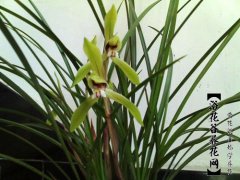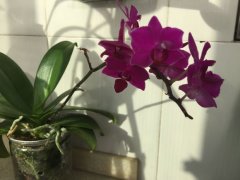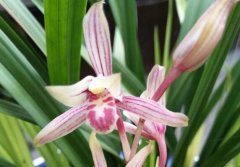What kind of root of orchid is dragon root?
OrchidThe "dragon root" and "dragon root seedlings" in the middle are divided into true and false. The so-called true "dragon root seedlings" are actually formed by the germination of seeds, also called "real seedlings". Everyone knows that,OrchidThe seeds are small, many, and very light. After the orchid capsule matures and cracks, the seeds are scattered in the original place where she was born and raised. When the wind is encountered, some of these light seeds will flutter with the wind, leaving their homes and flying away., Scattered in other places. The place where it landed is the mountainside rock wall, mountain woodland, and mountain gorge suitable for orchid growth. Some of the scattered seeds take root, sprout, and grow leaves there. They settle down and multiply and survive. In nature, orchid seeds germinate.Later, "dragon roots" first formed in the soil. This kind of "dragon roots" is not the root of orchids, but the rhizomes of orchids. When "dragon roots" grow to the soil, their tops swell to form small pseudobulbs, Grow roots downwards, grow leaves upwards, and grow into seedlings. This kind of orchid seedlings with "dragon roots" are called "seed seedlings", commonly known as "dragon root seedlings" or "dragon root seedlings". Generally speaking, Dragon root only has the original plant, and the secondary bud has no dragon root.
Dragon roots are small and dense, with short and crisp internodes. There are many nodes and internodes. Each node has a dormant bud, and each dormant bud may sprout a new seedling. NormallyIn other words, the lifespan of a dragon root is about 2 years. After the seedlings grow strong and the reeds are formed, the dragon eggs will fall off on their own, and the dragon eggs will no longer reappear. The dragon roots of the original plants will remain for a long time after they rot.Papillary objects, traces of dragon roots are faintly discernible.
There are two situations for true dragon roots and dragon root seedlings: one is the dragon root seedlings that germinate from a single seed. In nature, these dragon roots are mostly weak seedlings of a single seedling, each with only one dragonThe roots, directly below the buds, are in a vertical or nearly vertical state. In the mountains, most of the young individual orchid seedlings belong to this type of dragon root seedlings, and sometimes dozens of such dragon root seedlings can be picked at one time.The dragon root-like seedlings are weak and difficult to manage, and it is not easy to see flowers in 5-8 years. The second is ginger-shaped dragon roots. Ginger-shaped dragon roots, also known as massive dragon roots, are shaped like ginger and also like corals. The orchid stems from tubers.The ginger-shaped dragon root may be produced because tens of thousands of seed particles germinated densely at the same time after the orchid capsule fell to the ground, entangled with each other into a lump like a tuber. This kind of ginger-shaped dragon root sprouted dragon root seedlings sometimesEven dozens of seedlings grow together.
Some people have proposed that Longgen seedlings are easy to produce new varieties with a probability of about 1.4%. When evaluating Longgens, they said that the length of Longgens is better for the older ones, the shorter ones are worse, the short internodes are better, and the internodes are longer.Inferior. The more weird the dragon roots are, the better. Whether these views can be established remains to be further verified.
Regarding the formation of false dragon root seedlings. Under normal circumstances, orchid false bulbs are clustered together, and there is a short underground stem where they are connected. This underground stem grows in nature, for some reason, if you encounterWhen the buried soil is too deep or pressed by large rocks, growth is inhibited, and the survival of the orchid cluster is endangered, a relatively long bamboo root false dragon root will sprout, and it will stretch to a suitable place to form new shoots and grow roots.Leaves, and form new pseudo-bulbs. This bamboo-like underground stem is also commonly called "dragon roots". The growing plants are also called "dragon root seedlings."The "hard to find" dragon root may refer to the dragon root that this orchid plant is buried in the soil. Some people say that the domestic orchid plant, due to improper planting, will produce fake bulbs too deep in the potting soil.A similar situation. And it is proposed that there are many variations of this "Long Gen Miao", and this view has yet to be confirmed by the Lan friends.
In recent years, influenced by the idea that dragon root seedlings are prone to produce new varieties of mutation, many people are driven by profits or are eager to seek better seeds, blindly purchasing or digging up the mountains to dig dragon root seedlings, causing destruction of orchid resourcesIt’s true that the Hanguang and Wandaifu in the Taiwan Baosuilan inscriptions are all cultivated from dragon root seedlings. The double-petaled molan flower has odd root, odd carapace, odd leaf, dragon root and three-sided spines.Such characteristics, this is an indisputable fact. In fact, it is possible for dragon root seedlings to produce leaf art and bloom strange flowers, but this is only a possibility. Because inscriptions are originally rare and rare things.There are characteristics, but those with characteristics do not necessarily have strange flowers." "Longgen" is only one of the characteristics of a good orchid, but it is by no means that all dragon root seedlings with dragon roots will frequently produce good products.
- Related knowledge
- Introduction to the characteristics of the Mayor Red Orchid picture
- Can I spray orchids with lots of flowers?
- Does carbendazim cure orchid stem rot?
- Can orchid string disease still be raised?
- Orchid is a herb grown for several years no more than three
- How to deal with the old orchid seedlings cover the old seedlings
- What does orchid vernalization mean? Promote the growth of flower buds
- How to deal with orchids after blooming|How to cut flower stems
- See how veteran flower growers answer these two questions: Is orchid easy to raise? Can newbies raise these two questions
- What's wrong with the yellow leaves of orchids 12 types of yellow leaves
- When is the best time to water orchids | morning and evening
 Chunlan grass orchid breeding method
Chunlan grass orchid breeding method- Is the orchid fragrance toxic?
- Picture of orchid soft rot
- Summer orchid management
- Four taboos for growing orchids for the first time in the family
- How to breed Guolan experience
- Recognition map of spring orchid color, petal, leaf color
- How to grow orchids-a collection of experiences 1
- Editor's recommendation
- Molan breeding method
- Introduction of orchids and main rare varieties Chunlan
- Chunlan grass orchid breeding method
- The maintenance method of bottle orchid
- How to grow gladiolus flowers
- The cultivation method of purple root orchid
- Nine-section orchid nine head orchid, nine Hualan cultivation method
- Knowledge of cultivation and maintenance of Buddha bead spider plant watermelon spider plant
- The breeding and maintenance method of yellow pineapple
- Detailed explanation of bluegrass orchid



